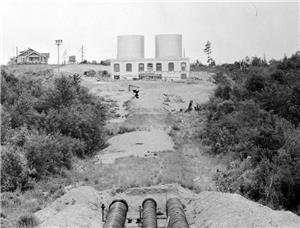On March 21, 1951, the City of Seattle Board of Public Works awards United Concrete Pipe Co. the contract to construct Cedar River Pipeline Number Four at a cost of $1,745,991.00. Originally called the Bow Lake Pipeline, the pipe would extend from the Lake Youngs Control Works, across the Green River Valley to end at Bow Lake, near the recently built Sea-Tac Airport.
The Bow Lake Pipeline was conceived as early as 1943, when Superintendent of Water W. C. Morse proposed the idea to Seattle City Councilman Bob Jones, on a list of proposed activities the city needed to consider when World War II ended. Plans for a major airport at Bow Lake were already being decided upon, and ample water was required.
By war’s end, the need was critical. Construction of the airport, along with postwar growth, created a large increase of homes being built south of West Seattle. Bids were called for in 1946, but all were considered to be too high. The pipeline was delayed.
Not Enough Water
Work began on a reservoir to be located immediately north of Sea-Tac, to be ready for the completion of the pipeline and the airport. The six-million-gallon reservoir was filled with water from the West Seattle reservoir, farther to the north. The airport was completed in 1949. As to the new Cedar River pipeline, the Public Works department kept waiting for construction costs to come down. They didn’t.
Within a year, use of the Bow Lake reservoir proved to be too taxing on the water system. Demand in West Seattle was growing, as was water use at the airport. In 1951, plans for the Bow Lake Pipeline were complete and bids were again called for. United Concrete Co. came in with the lowest.
Another War, Another Delay
By this time, the Korean War was in full swing, so steel was hard to come by. After a year-long delay, construction began in 1952. The pipeline began at the Lake Youngs Control Works, and consisted of 33,145 feet of 60-inch pipe, and 3,200 feet of 72-inch pipe. Crossing the Green River Valley, it ended at the Bow Lake reservoir at 24th Avenue S and S 160th Street.
The pipeline supplied 20 million gallons per day to the Bow Lake area (including Sea-Tac Airport), and 30 million gallons per day to West Seattle. It was placed in service on April 6, 1954.

